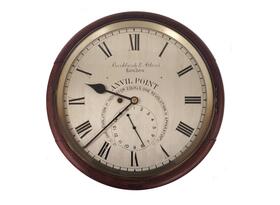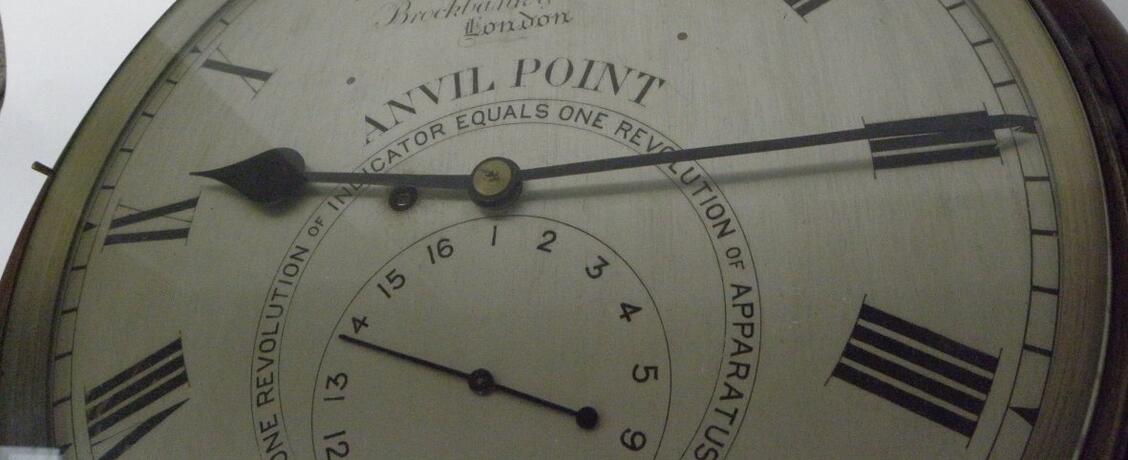Maritime History Adds Interest to Auction
Maritime History Adds Interest to Auction
by Elizabeth Talbot
One of the lots submitted to TW Gaze’s next dedicated Clocks & Watches auction is already causing a ripple of interest amongst maritime historians. Consigned by a private vendor from an East Suffolk coastal port, the late 19th Century eight-day circular wall time piece in a plain mahogany case is very unassuming in appearance. However, the silvered face carries an unusual subsidiary dial, numbered 1 – 16 and is handsomely engraved “Anvil Point. One Revolution of Indicator Equals One Revolution of Apparatus”. These words instantly provide the provenance and explain the purpose of this unique example of a rare type of clock. What’s more, the makers were Brockbank & Atkins of London.
Anvil Point is a lighthouse in the grounds of Durlston Country Park on the southeast Dorsetshire coastline, approximately two miles from Swanage. It was built by Trinity House in 1881 using locally quarried stone and its purpose was to provide a waypoint for vessels on passage along the English Channel coast, giving a clear line to the west from Portland Bill and to the east guiding vessels away from the Christchurch Ledge and leading them into the Solent.
Anvil Point was opened by Neville Chamberlain’s father, Joseph, who was Minister of Transport at the time. The light was originally illuminated by a paraffin vapour burner, and the fog signal was a small cannon giving a loud blast every five minutes.
Few examples of lighthouse clocks can be traced, but a similar clock, made specifically for the Belle Tout lighthouse, Beachy Head, Sussex, by the same specialist firm as the Anvil Point example, is in the collection of Royal Museums Greenwich. As the museum’s notes explain, every lighthouse has its own signatory “character” (the sequence and frequency of flashes) so that mariners can identify a lighthouse from its signal. The clock has a subsidiary dial to help regulate the character.”
The firm of Brockbank & Atkins was established when Cumbrian-born brothers John (1747 – 1806) and Miles (1754 – 1821) Brockbank, who trained as watchmakers in London and gained a reputation as preeminent manufacturers of marine chronometers, eventually went into partnership with clock and watchmaker, George Atkins (1767 – 1855). Subsequent generations of their families joined the business and together they were considered the most distinguished chronometer makers of late 18th and 19th Century London. The famous watchmaker George John Moore (1838 – 1916) joined the firm between 1885 and 1898 and during this time the firm’s name was Brockbank, Atkins & Moore, and this was to be found on their clock and watch output of the period. These details help to date the clock for sale in Diss on 16 May. It is signed Brockbank & Atkins and therefore suggests it was made for installation directly into the newly built Anvil Point lighthouse in 1881, as by 1885 it would have been signed Brockbank, Atkins & Moore.
Anvil Point was modernised in 1960 and converted to run on mains electricity. It was then automated in the last decade of the 20th Century when the old fog signal was replaced. Sometime during these various stages of works, the wall clock was deemed redundant and removed. It has been loved and cherished in recent years within sight and sound of the North Sea but is now looking for a new berth. It carries a pre-auction estimate of £800 – 1,200. Further information including catalogue details and viewing times to be found at twgaze.co.uk.
Meanwhile, Anvil Point lighthouse is now monitored and controlled from Trinity House’s Planning Centre in Harwich, Essex.

